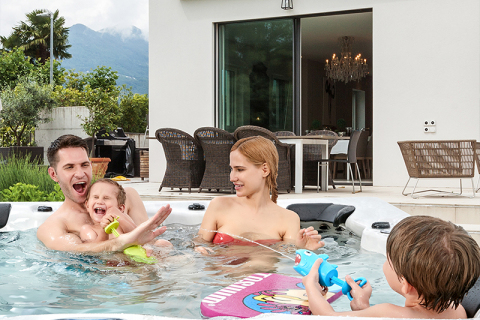
- Home
- >
News
The standard design load-bearing capacity of residential floors is typically 200–300 kg/m². If the spa jacuzzi tub has a small base area, for example, only 2 square meters, but the total weight reaches 800 kg, then the load-bearing capacity per unit area is as high as 400 kg/m², exceeding the normal safe range.
When the pH exceeds 8.0, carbonates precipitate under heating conditions, forming tiny suspended particles. These particles adhere to the foam interface, making the foam stronger and harder to dissipate. Therefore, high pH itself is not a "foam maker," but it is a "foam maintainer."
When we soak in the hot water of a spa jacuzzi bathtub for an extended period, some of the skin's natural oils are removed, and moisture is lost from the stratum corneum, weakening the skin's protective barrier and causing keratinocytes to loosen and shed. This physiological reaction is more pronounced in winter or in people with sensitive skin.
In a spa jacuzzi tub, the surrounding air humidity is high, making it difficult for the body to perceive moisture loss. Even if the body is "sweating," the warm, humid environment causes the sweat to quickly mix with water, so we don't feel it. However, the body's internal water is continuously decreasing through metabolism.
Not necessarily safe; it depends on the source of the foam and the water quality. If the foam is caused by residues of shampoo, conditioner, or detergents, it may contain fragrances, surfactants, etc., which can cause redness, itching, or contact dermatitis with prolonged contact or for those with sensitive skin.
In public, wearing a swimsuit is undoubtedly the safest option to respect others, maintain health, and maintain etiquette. In private, however, you can choose whether to wear one based on your personal preference. The ultimate goal is to ensure a comfortable and safe spa jacuzzi bathtub experience that is both personal and appropriate.
The requirement that a spa jacuzzi bathtub must be perfectly level stems from a comprehensive consideration of equipment performance, user safety, pump efficiency, and long-term maintenance costs. Whether for home or commercial use, the installation process must strictly adhere to leveling requirements. Never overlook this seemingly minor, yet crucial, technical step.
When we ask, "What do you put in your spa jacuzzi bathtub after each use?" the answer isn't just "disinfectant"; it should encompass a comprehensive set of cleaning and hygiene practices. Chlorine-based disinfectants, oxygen-based disinfectants, and specialized system cleaning solutions—each solution has its own applicable scenarios and technical requirements.
Generally speaking, for a large, standard-sized outdoor spa jacuzzi tub (approximately 2.2 meters square), six to eight people are recommended for ground handling. For high-altitude installation or in complex terrain, this number should be increased to eight or more people, using a combination of lifting equipment and a sliding rail system.
One of the core components of a swim spa jacuzzi tub is the pump, responsible for moving water, circulating it within the tub, and driving the massage jets. A water pump generates some vibration during operation. If this vibration is not effectively absorbed or secured, it may cause noise.
While spa jacuzzi bathtubs are designed to provide a comfortable hydrotherapy experience, if not properly maintained, the water within them can become a breeding ground for bacteria, fungi, and other microorganisms. These microorganisms can accumulate in the tub's jets and plumbing, especially if the water is not properly filtered and disinfected.
Poor air circulation in a spa jacuzzi bathtub environment can also cause breathing difficulties. Many people choose to close the doors and windows around the bathtub to maintain warmth, but this can also result in poor air circulation.












